What would your future-you have to say to you?
The no-pants guide to spending, saving, and thriving in the real world.
What would your future-you have to say to you?
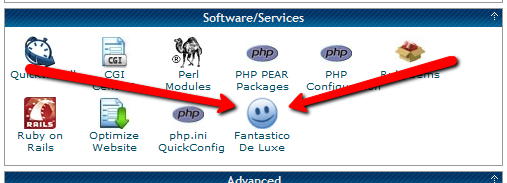
In this installment of the Make Extra Money series, I’m going to show you how to set up a WordPress site. I’m going to show you exactly what settings, plugins, and themes I use. I’m not going to get into writing posts today. That will be next time.
I use WordPress because it makes it easy to develop good-looking sites quickly. You don’t have to know html or any programming. I will be walking through the exact process using Hostgator, but most hosting plans use CPanel, so the instructions will be close. If not, just follow WordPress’s 5 minute installation guide.
Assuming you can follow along with me, log in to your hosting account and find the section of your control panel labeled “Software/Service”. Click “Fantastico De Luxe”.

On the Fantastico screen, click WordPress, then “New Installation”.
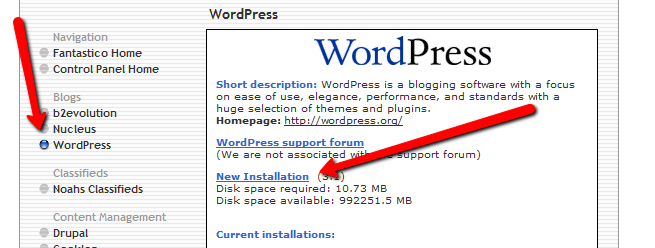
On the next screen, select your domain name, then enter all of the details: admin username, password, site name, and site description. If you’ll remember, I bought the domain http://www.masterweddingplanning.net. I chose the site name of “Master Wedding Planning” and a description of “Everything You Need to Know to Plan Your Wedding”.
Click “install”, then “finish installation”. The final screen will contain a link to the admin page, in this case, masterweddingplanning.net/wp-admin. Go there and log in.
After you log in, if there is a message at the top of the screen telling you to update, do so. Keeping your site updated is the best way to avoid getting hacked. Click “Please update now” then “Update automatically”. Don’t worry about backing up, yet. We haven’t done anything worth saving.
Next, click “Settings” on the left. Under General Settings, put the www in the WordPress and site URLs. Click save, then log back in.
Click Posts, then Categories. Under “Add New Category”, create one called “Misc” and click save.
Click Appearance. This brings you to the themes page. Click “Install Themes” and search for one you like. I normally use Headway, but before I bought that, I used SimpleX almost exclusively. Your goal is to have a simple theme that’s easy to maintain and easy to read. Bells and whistles are a distraction.
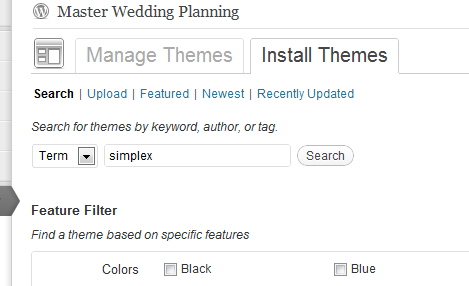
Click “Install”, “Install now”, and “Activate”. You now have a very basic WordPress site.
A plugin is an independent piece of software to make independent bits of WordPress magic happen. To install the perfect set of plugins, click Plugins on the left. Delete “Hello Dolly”, then click “Add new”.
In the search box, enter “plugin central” and click “Search plugins”. Plugin Central should be the first plugin in the list, so click “install”, then “ok”, then “activate plugin”. Congratulations, you’ve just installed your first plugin.
Now, on the left, you’ll see “Plugin Central” under Plugins. Click it. In the Easy Plugin Installation box, copy and paste the following:
All in One SEO Pack Contact Form 7 WordPress Database Backup SEO SearchTerms Tagging 2 WP Super Cache Conditional CAPTCHA for WordPress date exclusion seo WP Policies Pretty Link Lite google xml sitemaps Jetpack by WordPress.com
Click “install”.
On the left, click “Installed Plugins”. On the next screen, click the box next to “Plugins”, then select “Activate” from the dropdown and click apply.
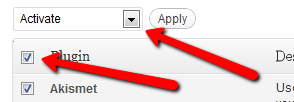
Still under Plugins, click “Akismet Configuration”. Enter your API key and hit “update options”. You probably don’t have one, so click “get your key”.
The only tool I worry about is the backup. It’s super-easy to set up. Click “Tools”, then “Backup”. 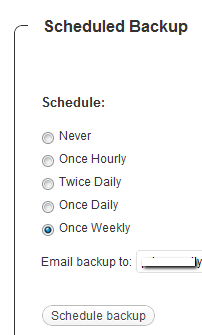
Scroll down to “Schedule Backups”, select weekly, make sure it’s set to a good email address and click “Schedule Backup”. I only save weekly because we won’t be adding daily content. Weekly is safe enough, without filling up your email inbox.
There are a lot of settings we’re going to set. This is going to make the site more usable and help the search engines find your site. We’re going to go right down the list. If you see a section that I don’t mention, it’s because the defaults are good enough.
Set the Default Post Category to “Misc”.
Visit this page and copy the entire list into “Update Service” box. This will make the site ping a few dozen services every time you publish a post. It’s a fast way to get each post indexed by Google.
Click “Save Changes”.
Uncheck everything under “Email me whenever…” and hit save. This lets people submit comments, without actually posting the comments or emailing me when they do so. Every once in a while, I go manually approve the comments, but I don’t make it a priority.
Select “Custom structure” and enter this: /%postname%/
Click save.
Set the status to “Enabled”, then fill out the site title and description. Keep the description to about 160 characters. This is what builds the blurb that shows up by the link when you site shows up in Google’s results.
Check the boxes for “Use categories for META keywords” and “Use noindex for tag archives”.
Click “Update Options”.
Check the boxes to remove each of the dates and set the alt text to “purpose” or something. This will suppress the date so your posts won’t look obsolete.
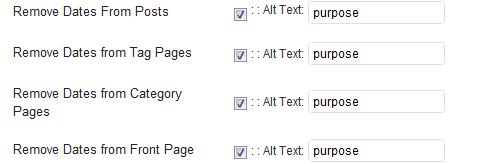
This plugin reinforces the searches that bring people to your site. It’s kind of neat. Skip the registration, accept the defaults and hit save.
Scroll to the bottom and click import. We’ll come back to this.
Select “Caching On” and hit save.
Across the top of the screen should be a giant banner telling you to connect to WordPress.com and set up Jetpack. You’ll need an account on WordPress.com, so go there and set one up. After authorizing the site, you’ll be brought back to the Jetpack configuration screen. Click “Configure” under “WordPress.com Stats”. Take the defaults and hit save.
On the contact configuration page, copy the code in the top section. You’ll need this in a moment.
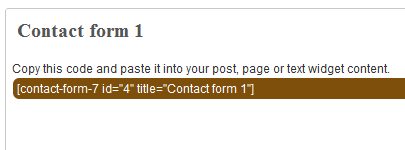
Now, we going to create a couple of static pages. On the left, click “Pages”, then “Add new”.
Name the first page “Contact” and put the contact form code in the body of the page. Hit publish.
Under Appearance, click “Menu”. Enter a menu name and hit save.
Then, under “Pages”, click the box next to “Contact”, “Disclaimer”, and any other policies you’d like to display. Hit save.
Also under Appearance, click “Widgets”. This is where you’ll select what will display in the sidebar. All you have to do is drag the boxes you want from the middle of the page to the widget bar on the right. I recommend Text, Search, Recent Posts, Popular Search Terms and Tag Cloud. In the text box, just put some placeholder text in it, like “Product will go here”. We’ll address this next time.
We’re not going to worry about getting posts in place, yet. That will be the next installment. However, the steps in the next installment could take 2 weeks to implement, and we want Google to start paying attention now. To make that happen, we need to get a little bit of content in place. This won’t be permanent content. It’s only there so Google has something to see when it comes crawling.
To get this temporary, yet legal content, I use eZineArticles. Just go search for something in your niche that doesn’t look too spammy.
Then, click “Posts”, then delete the “Hello World” post. Click “Add new”. Copy the eZine article, being sure to include the author box at the bottom, and hit publish.
To see your changes, you may have to go to Settings, then WP Cache and delete the cache so your site will refresh.
Congratulations! You now have a niche blog with content. It’s not ready to make you any money, yet, but it is ready for Google to start paying attention. In the next installment, I’ll show you how I get real unique content and set it up so Google keeps coming back to show me the love.
Ever since she was a little girl, my wife has wanted to be a horse. Err, work with horses.

The problem is that most jobs working with horses pay horse-crap. It’s hard to raise a family on a stablehand’s income.
Her alternative was to own horses. This comes with a different set of problems. The biggest problem is that we live on 1/8 of an acre in a first-ring suburb. That’s not a lot of room to graze, though I would be willing to give up my spot in the garage.
I rock like that.
Boarding a horse costs a minimum of $200 per month. Two girls means two horses, otherwise, they won’t both be able to score in the saddle club. For the math challenged, that’s $400 per month, plus about $300 in preventative vet care per year.
$5100 for a year of boarding an extremely obsolete car.
Then, you need a trailer to get the horse to shows. You need saddles and reins and and short-legged stirrups and feedbags and muck-rakes and brushes and combs and hoof-cleaning-thingies and other stuff that will catch me by surprise for years to come.
Expensive.
My rough estimate is that it costs at least $10,000 to get into horse ownership, and that’s not counting the horse itself.
You can buy a horse for well under $1000 if you aren’t concerned about registration or speed. A 15 year old horse can last 10-15 more years, so it’s not money down the drain.
That’s $12,000 to get in and $5100 per year to stay in. Minimum.
Never let it be said that I’m not a pushover. Last month, we bought an SUV that can pull a horse trailer. Last weekend, we bought the trailer. That’s two major steps towards making my wife’s dreams come true. The rest of the plan culminates in a hobby farm in the sticks.
There are several steps in between.
I just need to put the brakes on every other step. We’ve been offered the free use of one pony next season, and we may be able to get another for the same price. Beyond that, we need to be patient. There will be no ponies purchased until the new truck and old mortgage are paid.
Period.
Today, I continuing the series, Money Problems: 30 Days to Perfect Finances. The series will consist of 30 things you can do in one setting to perfect your finances. It’s not a system to magically make your debt disappear. Instead, it is a path to understanding where you are, where you want to be, and–most importantly–how to bridge the gap.
I’m not running the series in 30 consecutive days. That’s not my schedule. Also, I think that talking about the same thing for 30 days straight will bore both of us. Instead, it will run roughly once a week. To make sure you don’t miss a post, please take a moment to subscribe, either by email or rss.
On this, day 2 of the series, you need to gather all of your bills: your electric bill, your mortgage, the rent for your storage unit, everything. Don’t miss any.
Go ahead, grab them now. I’ll wait.
Did you remember that thing that comes in the plain brown wrapper every month? You know, that thing you always hope your neighbors won’t notice?
Now, you’re going to sort all of the bills into 5 piles.
Pile #1: These are your monthly bills. This will probably be your biggest pile, since most bills are organized to get paid monthly. this will include your credit cards, mortgage(do you rent or buy?), most utilities and your cellphone.
Pile #2: Weekly expenses. When I look at my actual weekly bills, it’s a small stack. Just daycare. However, there are a lot of other expenses to consider. This stack should include your grocery bill, gas for your car, and anything else you spend money on each week.
Pile #3: Quarterly and semiannual bills. I’ve combined these because there generally aren’t enough bills to warrant two piles. My only semi-annual bill is my property tax payment. Quarterly bills could include water & sewer, maybe a life insurance policy and some memberships.
Pile #4: Annual bills. This probably won’t be a large pile. It will usually include just some memberships and subscriptions.
Pile #5: Irregular bills. The are some things that just don’t come due regularly. In our house, school lunches and car repairs fall into this category. We don’t have car problems often, but we set money aside each month so our budget doesn’t get flushed down the drain if something does come up.
Now that you have all of your expenses together, you know what your are on the hook for. Next time, we’ll address income.
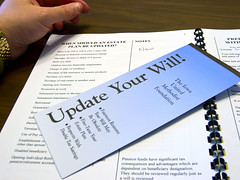
With the new year looming, it’s the perfect time to review the things that may not have gone as well as planned in the current year, and plan ahead for the coming year, to make sure things go well from now on.
To get a good start in the new year, you should focus on three things.
A good budget is the basis of every successful financial plan. If you don’t have a budget, you have now way of knowing how much money you have to spend on your necessities or you luxuries. Do you really want to guess about whether or not you can afford to get your car fixed, or braces for your kid? I’ve gone over all of the essentials to make a budget before. Now is the perfect time to review that series and make sure your own budget is functional and ready for the new year.
At the same time, spend some time thinking about how your what has gone wrong with your budget over the previous year. In my case, when we got back from vacation in August, our mindset had changed a bit about spending money, and we got out of the habit of staying strictly on budget. By the time we got back on track, it was Christmas and our plans got shot, again. If it weren’t for my side hustles–money that I don’t track in the budget because the money isn’t consistent, yet–we would have had some serious problems this fall. Where have you gone wrong, and what could you do to improve next year?
In the new year, if you haven’t already done so, make sure you throw your credit cards away. The most basic law of debt reduction is, “If you don’t stop using debt, you’ll never be out of debt.” That’s why you need to set up your budget first. Make sure that your expenses are less than your income, so you can make ends meet without having to charge the difference.
How has your debt use worked out over the last year? Have you used it at all, or have you eliminated the desire to pay interest? What have you used your credit cards for? How much of that could you have done without?
Now is the time to make sure that all affairs are in order, if the worst should happen. If you die, what happens to your money? Your kids? I’ve gone over everything you need in an estate plan before, so I won’t beat that horse again. You owe it to your family to make sure they are taken care of if something should happen to you. At a bare minimum, write a will and get it notarized.
Have you putting off writing your will? You know you need one, but it’s a morbid thought, so it’s easy to put off, right? Get over it. If you love your family, you’ll do better and get your affairs together next year.
That’s a good financial start for 2011. What are you missing in your financial life?
If you’re like millions of people who saw Miley Cyrus’s performance at the MTV Video Music Awards recently, you’ve probably wondered what the effect of massive success on the music and acting star. Cyrus seems to be

doing everything possible to remake her image in the exact opposite of her squeaky clean mold that Disney and other companies have created for her over the last several years. (A rumor has it that Disney even created a contractual obligation for Cyrus to maintain a certain haircut during her “Hannah Montana” television show.) There’s a sense of someone taking on their first sense of independence, and running with it — the star seemed to be sending the message to the audience that she was not going to live according to the expectations of others anymore, and from the look of it, they got that message loud and clear.
The fact that Cyrus is barely into her 20s should tell you something about how much time she has to develop her career. She has enough to retire at an age when most people are just starting their first real job. And that is a tough position to be in. If she is hoping to push her singing and acting career well into adulthood — as most artists would like to — it may be that she is trying to make her mark now. Think of it a bit like Bob Dylan in 1964, releasing electric music for the first time, when before that point he was primarily known as a folk singer making gentle acoustic music.
Dylan’s idea may have been a bit like what Cyrus’ is. That is to say, maybe Miley Cyrus is trying to avoid becoming a has-been, a relic of the 2000’s who burned out playing inoffensive pop music. If this is the case, Cyrus may be able to shift her career into a different mode by showing herself to be an uncompromising artist. Remember that even the greats of the past — Frank Sinatra for example — were once viewed as essentially music for teenagers, and not serious artists. Sinatra even suffered career failure in his 20’s when his audience grew up and moved on to other things. But he came back to record success when he began allowing his music to mature and his ideas to gain focus. If Cyrus can pull such a move, she may not be remembered as a teeny-bopper, but as a serious artist.